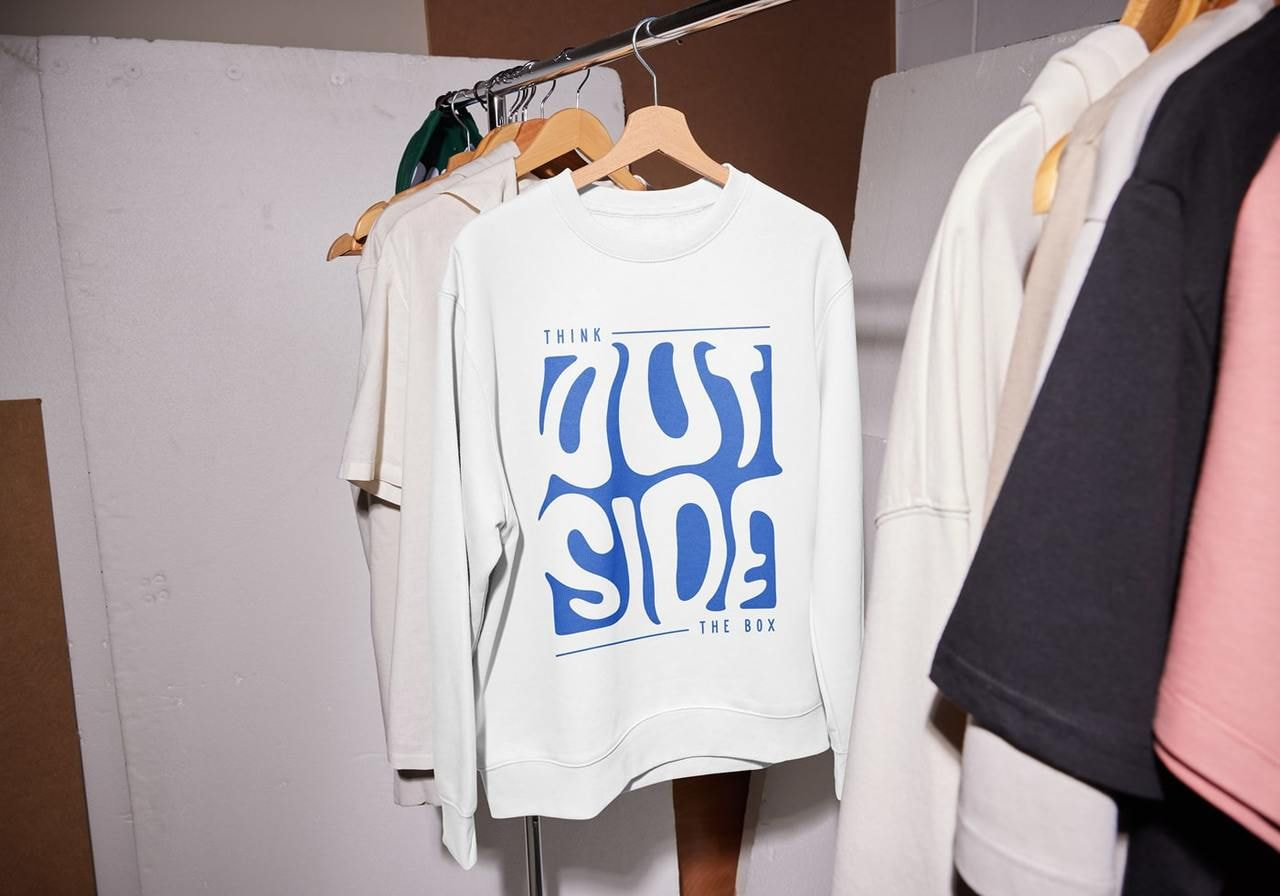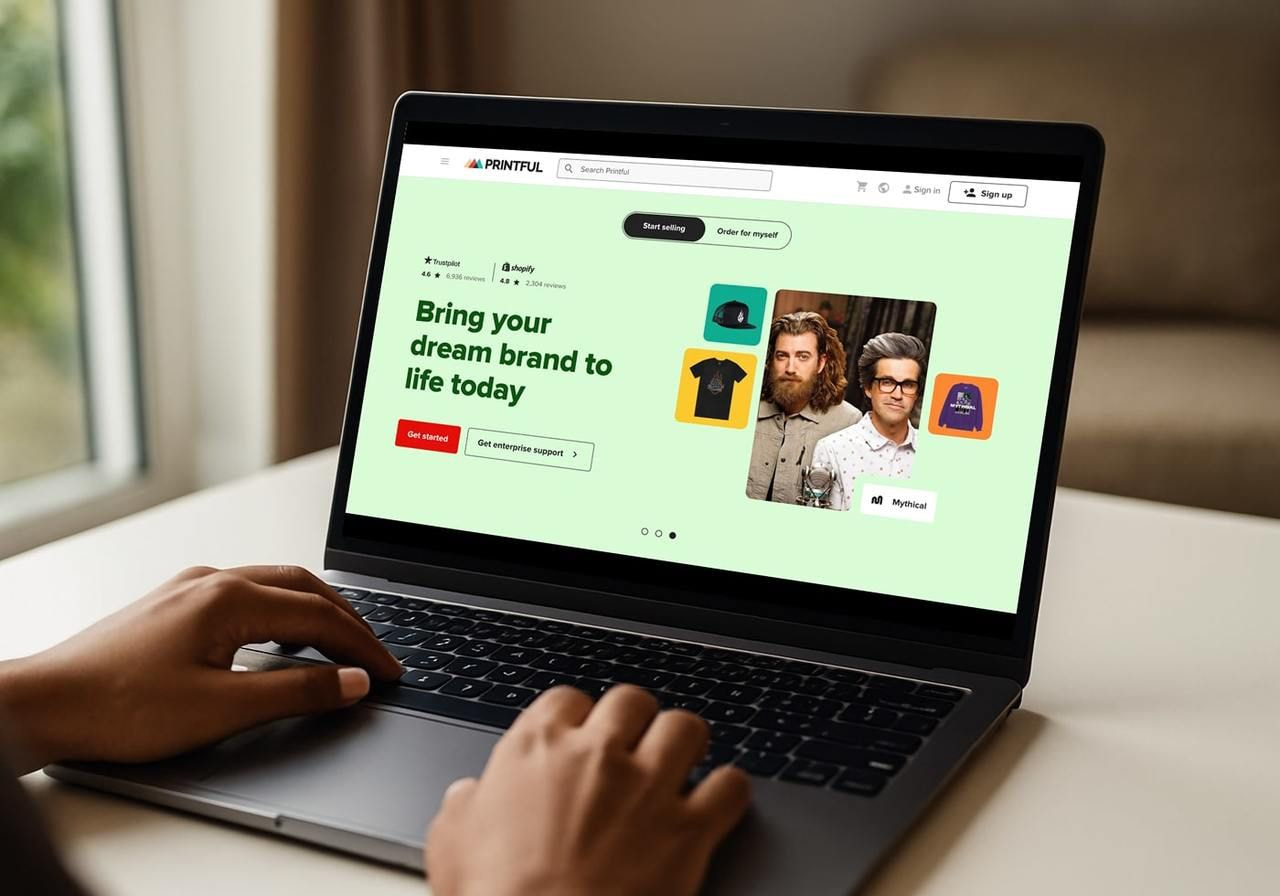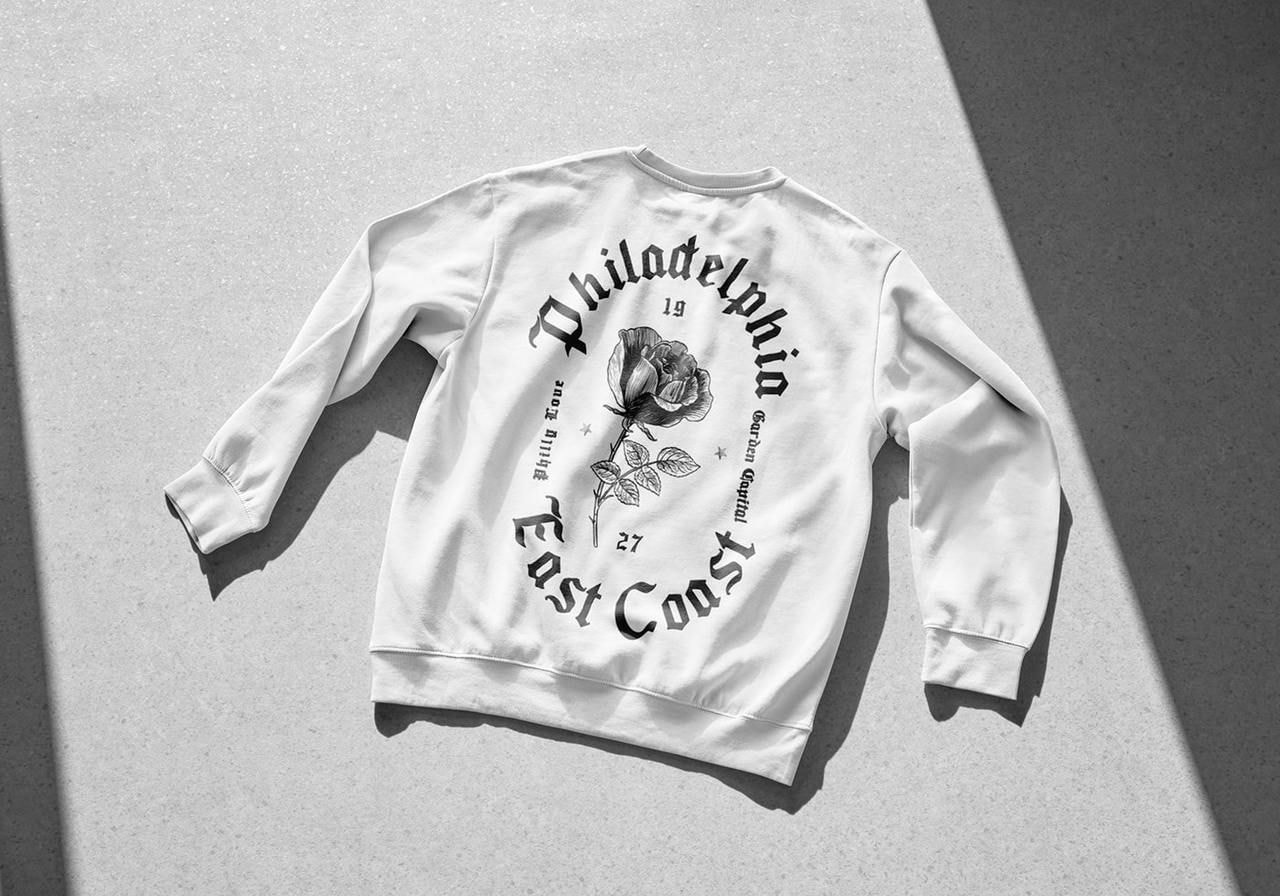Table of contents
Want to launch a business but have no capital? You’re not alone. Thousands of entrepreneurs are building profitable eCommerce stores without money.
The eCommerce market’s projected to hit $47.7T by 2030. There’s never been a better time to start an online store – without spending upfront.
In this guide, you’ll learn how to start an eCommerce business without money, using tested methods that work in 2025:
-
Zero-inventory models like Print on Demand and dropshipping
-
Free tools for product creation, design, and marketing
-
Smart platform choices to avoid setup fees
-
Tactics for validating your business idea, building traffic, and getting sales
You’ll get step-by-step instructions, real examples, and high-performing eCommerce business ideas, so you can skip the fluff and start building a profitable online business.
Main takeaways
-
Pick a low-cost business model, like Print on Demand or digital products
-
Sell through a free trial platform or marketplace to avoid setup and hosting fees
-
Save marketing costs by building trust and visibility with high-quality listings, clear messaging, and consistent communication
-
Focus on getting repeat customers – they’re easier to convert and more valuable in the long term than one-off buys
Why start an eCommerce business?
eCommerce is one of the only business models you can start without inventory, rent, or a significant upfront investment. With low-cost business models like Print on Demand or dropshipping, suppliers handle production and shipping while you focus on sales.
Starting an eCommerce business from scratch is low-risk and high-potential. It’s a practical option for students, side hustlers, and anyone looking to build a profitable online business without spending money upfront.


How to start an eCommerce business without money in 8 steps
You don’t need capital to start your own eCommerce business. Free platforms, hands-off business models, and organic marketing channels make it possible to launch, grow, and sell – without spending upfront.
Here’s how to start your online business in 8 clear steps.
1. Choose a low-cost business model
The first step to figuring out how to start an online store with no money is to pick a business model with low startup costs. The right model lets you launch without inventory, rent, or capital – just an internet connection and a clear offer.
Here are the top ways to sell products online for small business owners:
-
Print on Demand (POD)
POD lets you sell custom products (apparel, home goods, accessories) under your brand without holding inventory. You design the products, and your POD partner handles printing, packing, and shipping after each sale. First, you need to choose a print provider you’ll work with.

Read more: 15 Best print-on-demand companies for your business
Second, set up a store on an eCommerce platform or marketplace and connect it to your print-on-demand provider. Once set up, orders are fulfilled automatically, so you can focus on marketing and growth.
If you partner with a white-label company like Printful, your customers will only see your brand – not your supplier’s. You’ll get access to 460 products, from custom hoodies and t-shirts to accessories, mugs, and wall art. All items are printed and shipped under your label.
POD is a kind of dropshipping that allows you to customize the products you sell.
You can start a clothing line and sell custom hoodies, custom t-shirts, joggers, and more.
See how other business owners made it by checking out successful print-on-demand store examples.
Dropshipping is another low-cost business model where a third-party supplier handles production, packaging, and shipping. You don’t need to manage inventory – orders are fulfilled on demand after each purchase.
Unlike POD, most dropshipping products aren’t customizable. But branded dropshipping does exist – it allows you to add packaging, logos, or product inserts for a more cohesive customer experience.
Read more: 15 Profitable dropshipping business ideas to try in 2025
-
Sell digital products
No inventory, no shipping – just pure margins. In this business structure, digital products like eBooks, courses, Notion templates, or design packs are created once and sold repeatedly.

You don’t need to be a designer or coder either. Free tools like Canva, Tella, or Gumroad make it easy to create, package, and sell digital products without spending money upfront. If you have knowledge or skills people want to learn, this is one of the most scalable business models.
If you already have a blog, newsletter, or social following, consider launching a paid membership or digital subscription. Writers, educators, and creators often turn their content into recurring income thanks to their existing online communities.
-
Affiliate marketing
Affiliate marketers earn by recommending services or other people’s products. You share a custom link, and every time someone buys through it, you get a commission.
Whether you’re writing blog posts, sharing TikToks, or reviewing gear on YouTube, you can build income with only an internet connection and your phone.
Many affiliate programs offer free signups and competitive rates. Printful’s Affiliate Program gives 10% of every referred order. Others to explore: Amazon Associates, ShareASale, Impact, and niche affiliate networks tied to specific industries.
-
Preselling
Got a business idea but not the funds to launch it? Sell it before you make it.
With preselling, you test demand and generate income before spending a dollar on production or online advertising. You’ll need a compelling product page, a captivating hook, and a clear delivery timeline.
It’s popular for launching books, brands, and courses without taking on risk. Even big brands like Rare Beauty used presales to build hype and validate demand.
-
Sell handmade products
If you’re crafty, whether you crochet, make jewelry, or design stickers, start small and scale over time.

List your handmade products on Etsy or sell directly through social media platforms.
Use short-form video to show your creative process and build trust. Social media posts attract customers and turn followers into buyers – even without paid ads or a full eCommerce website.
-
Social commerce
Social commerce – selling through livestreams and social platforms – is growing fast. TikTok Shop, Whatnot, Instagram Live, and other social media platforms all let you sell products during livestreams, and conversions are 5-10 times higher than traditional online stores.
This model is perfect if you’re comfortable on camera. All you need is a phone, a product, and some personality. Platforms handle the checkout and shipping for you.
The worldwide social commerce market will reach $1,581.9 billion in 2025 and grow nearly 4 times by 2030.
-
Subscription boxes
This business idea combines curation, community, and recurring revenue. You bundle products, either sourced or handmade, and ship them monthly to subscribers.
You don’t need to scale immediately. A small run of themed boxes (think wellness kits, art supplies, or indie snacks) lets you test the market. Use pre-orders to fund your first batch and gather feedback before investing more.
To manage signups, use tools like Subbly or Shopify’s built-in subscriptions.
2. Find products with a high profit margin
The next step in starting an eCommerce business from scratch is finding products. Look for items that cost little to produce or source but can be sold at a strong markup without compromising customer value.
Here’s how to do that:
-
Use product research tools
Don’t guess – use free or low-cost tools like Oberlo, Jungle Scout, or Sell The Trend to spot high-demand, low-competition products. TikTok Creative Center shows trending products in real time, making it easier to catch momentum before it peaks.
-
Go niche
Niche products that solve specific problems for a specific audience tend to sell better and support higher markups. Think “custom dog bandanas for large breeds” instead of just “pet accessories.”
-
Sell customizable or white-label products
White-label products with branding potential let you charge more. POD is ideal here: offer one-of-a-kind designs on clothing, drinkware, or home goods without paying for inventory. Buyers pay more when a product feels unique or tailored to them.

When sourcing products, ensure you partner with a trustworthy manufacturer. Look for consistent quality, fast fulfillment, and branding options like custom labels or packaging. These extras can justify premium pricing, significantly improve your profit margins, and ensure customer satisfaction.
-
Follow trends, but stay evergreen
Trending products (like viral TikTok finds) drive fast traffic, but lose momentum just as quickly. If you go all-in on a passing fad, you’ll end up with products no one wants in a month.
Use trends to attract attention, then funnel the potential customers toward stable, higher-margin items. For example, creators like Nadia the Artist blend trend-based collections (like Halloween prints) with timeless bestsellers to keep profit steady year-round. Tools like Google Trends and Pinterest Trends highlight rising demand before it peaks.
-
Consider a subscription model
Subscription products bring in recurring revenue. Subscriptions to supplements, books, beauty kits, or planners let you sell once and earn monthly.
Margins grow over time because customer acquisition costs go down. Start small with a curated box or digital subscription, and refine it based on feedback and retention.
Bonus tip for dropshippers:
Look for high-margin, lightweight products that ship easily – like LED gadgets, fitness gear, or kitchen tools. These are easier to scale and often come with lower fulfillment costs.
Read more: 11 High profit margin dropshipping products
3. Partner up with a supplier
If you’re building an eCommerce business with no money, your supplier is the engine behind your operations. They’ll handle production, packaging, storage, and shipping, so you can focus on design, marketing, and customer experience.

Customers don’t care if you made the product yourself: they care that it arrives on time, looks great, and works as expected. That’s why the right supplier is critical not just for logistics, but for your reputation, repeat sales, and long-term growth.
Consider these points before signing a deal:
-
Quality and product selection. High-quality products build trust with your customers. They result in fewer complaints and higher returns on investment (ROI). Choose a supplier offering a wide selection of trending products and a proven track record of quality. Request samples if possible to check the quality before selling.
-
Shipping price. Over 90% of shoppers say they’re likely to abandon shopping carts if the shipping costs are too high. And a huge emphasis is on reliability, so choose partners that deliver the orders on time. Find out more about Printful’s order fulfillment times.
-
Reputation and transparency. Pick a supplier with verified reviews, clear return policies, and detailed product info. With Printful, you’re choosing the best in the industry, according to over 31 thousand reviews.
-
Location and global reach. Suppliers close to your customers offer faster shipping and lower costs. Look for fulfillment centers in your primary markets to avoid delays and high shipping fees. Printful offers global fulfillment thanks to its facilities and trusted partners worldwide.
-
Support and communication. Good customer support prevents lost sales and stress. Choose suppliers with 24/7 service and fast response times. Test their support before committing.
4. Leverage free tools and resources
Once you’ve chosen your products and supplier, the right free tools will help you run and grow your business without upfront costs.
-
Design and branding: Use Canva and Printful’s Design Maker to create polished visuals and product assets.
-
Marketing: Use MailerLite or Beehiiv for email, and Later or Buffer to automate social media posts.
-
Growth: Monitor traffic with Google Analytics, manage projects with Trello or Notion, and brainstorm content ideas using ChatGPT.
Use what’s free until your business earns money. Then, reinvest in tools that save time and support long-term growth.
5. Create products
If you’re using POD, this is where your creativity turns into revenue. The right product designs help you stand out, express your brand, and boost perceived value.

With Printful, you can design 460 products with our free Design Maker. Through the Design Maker, you gain access to:
-
712 fonts
-
Over 300 clipart collections
-
More than 3100 ready-made, customizable designs
-
Over 550 background graphics and 175 colors
Read more: 11 Things you didn’t know Printful’s Design Maker could do


Read more: How to start a print-on-demand business in 2025 in 8 steps
6. Choose your selling platform

Where you sell custom products matters just as much as what you sell. Your eCommerce site shapes your brand, customer experience, and long-term growth, so choose the option that fits your goals, audience, and budget.
Here are the 4 main routes.
Quick Stores is the fastest and most accessible way to start an eCommerce business with no money. Launch a fully functional store in minutes – no coding, setup fees, or third-party platform. Everything from product creation to order fulfillment is handled in one place.
Pros:
-
100% free – no hosting, subscriptions, or setup costs
-
Go live in minutes
-
460 products to sell
-
Printful handles printing, shipping, and delivery
-
One dashboard to manage products, store, orders, and payouts
Cons:
-
Limited customization – no control over store design beyond logo, business name, and product descriptions
-
Currently available only to US-based sellers and US shipping
-
Store URL is hosted under Printful’s domain (not your own)
Best for sellers who want the simplest, fastest, and lowest-cost way to start an eCommerce business with no money.
-
eCommerce platforms
eCommerce platforms like Shopify, WooCommerce, and BigCommerce let you create your own online store without coding. They offer design templates, plugins, and tools for managing products, orders, and marketing.
Many platforms offer free plans or trials, but some require a small monthly fee. For more, check out our breakdown of the pricing, pros, and cons for 11 of the best eCommerce platforms.
Pros:
-
Full control over your store’s design, branding, and customer journey
-
Custom domain, built-in analytics, and SEO features
-
Easy integration with print-on-demand services like Printful
-
Highly scalable – add apps as your business grows
Cons:
-
Initial setup takes more time
-
Monthly fees for advanced features (e.g., Shopify starts at $29/month)
-
May require some tech confidence to customize
Best for sellers who want complete control, plan to build a long-term brand, and grow through SEO.
-
Online marketplaces
Marketplaces like Amazon, eBay, and Etsy give you instant access to a built-in, ready-to-shop customer base. You don’t need to build a website, and many marketplaces let you list products for free.
Pros:
-
Built-in traffic – customers are already searching for products like yours
-
Fast setup and simple listing process
-
Strong buyer trust and secure payment systems
Cons:
-
Sales and listing fees can eat into profits (e.g., Etsy charges 6.5% + listing and transaction fees)
-
Limited customization and brand control
-
High competition – your products appear next to thousands of others
Best for sellers who want a fast launch, minimal setup, and access to an existing customer base.
Read more: Marketplace vs. eCommerce platform: Which is the best?


7. List your products and start selling
Now it’s time to list your products. This is where you either stand out or disappear. Here are 5 tips to get them right on the first try for your own business.
1. Use high-quality photos
Shoppers can’t touch or test your product. They rely entirely on visuals. Use clear, quality images (at least 1000 × 1000 px) to meet most marketplace standards.
You can either order your products and make photos yourself, or use Printful’s Mockup Generator to create free product photos.
Lifestyle images (e.g., a person wearing the product) increase trust and sales.

2. Write compelling product descriptions that captivate your audience
Explain the product, who it’s for, and why it’s worth buying. Good descriptions remove doubt and help customers make confident decisions.
Focus on:
-
Benefits, not just features
-
Key details like materials, sizing, and care instructions
-
Easy-to-read formatting (short paragraphs, bullet points)
3. Set competitive pricing
Start by checking what similar products sell for. Then calculate your own base costs (including fulfillment and platform fees) and build in a healthy profit margin.
You don’t have to be the cheapest. Customers will pay more if your design, message, or niche is unique.
Read more: 8 Ways to market expensive products so they look like a steal
4. Provide stellar customer service
Quick replies, clear communication, and fair resolutions build trust and loyalty among the target audience. By being helpful, responsive, and respectful, any online business can build a strong reputation.
Repeat customers are better for business because:
-
They have a bigger average spend than new customers
-
Their loyalty grows with every good experience
-
They’re easier to convince with future deals
8. Market your business
You don’t need a budget to start making sales. With the right free tools and tactics, you’ll get traffic to your store, attract potential customers, and build revenue.
Here are the most effective ways to market your eCommerce business with little to no upfront cost.
-
Email marketing
Email remains among the highest-ROI marketing tools, returning around $42 for every $1 spent. Build your list early.
Use a free plan from MailerLite, Klaviyo, or Mailchimp to send newsletters, product updates, and abandoned cart reminders.
Even a small list can generate sales, especially if you segment your audience and personalize messages.
Tip: Offer a free download, discount, or behind-the-scenes content to encourage signups.
-
Influencer marketing
You don’t need to pay mega influencers. Microinfluencers (1K-100K followers) often promote products for reasonable fees or in exchange for free items, especially if your niche aligns with theirs.

Find creators who already speak to your target audience. Platforms like TikTok Creator Marketplace, Collabstr, or just direct DM outreach will help you connect.
Read more: 5 Steps for running the perfect microinfluencer campaign
-
Optimize for search engines (SEO)
SEO strategy is one of the lowest-cost marketing strategies for starting a business with no money. Whether you’re selling on an online marketplace or your own custom site, optimizing for search helps people find your products.
On your own website, focus on Google rankings by using tools like Keyword Tool to find relevant search terms for free. Then optimize your product titles, descriptions, blog content, image alt text, and page speed.
Marketplaces like Etsy or Amazon are their own search engines. Focus on platform-specific keywords, tags, and listing structure.
Learn more about marketplace optimization in our Etsy, Amazon, and eBay SEO guides.
Read more: What is SEO and how it works – A beginner’s guide
-
Use social media marketing
Social media is free and powerful, but only if you post with purpose. Focus on the platforms your audience uses, whether that’s TikTok, Instagram, or Pinterest.

Mix product content with educational, entertaining, or behind-the-scenes posts. And don’t just post: engage by commenting, replying to DMs, and joining relevant conversations.
Read more: 10 Effective social media strategies for your print-on-demand business
-
Analyze and adjust
Marketing looks different for every business, so don’t rely on guesswork. Use free tools like Google Analytics or your eCommerce platform’s built-in insights to track what’s working.
Pay attention to traffic, clicks, and conversions. Look at the data, spot the patterns, and adjust. You don’t need to be perfect to grow. Just test, learn, and keep improving.
Time to build your own successful business
Thankfully, the time when you needed tons of resources to become a business owner is gone. With the right tools, you can learn how to start an eCommerce business without money – and make it work.
Use low-cost options like Print on Demand and other business models to create custom products and make money online.
The best time to start is now. The sooner you get your first product out there, the sooner you’ll learn what works – and start building real momentum.
Read next: Clothing line business plan guide
FAQ
Yes, you can start an eCommerce business with no money. Use free tools, organic marketing strategy, and low-cost business models like Print on Demand, dropshipping, or affiliate marketing. These models let you sell online without paying for inventory, packaging, or warehousing.
How to start an online store for free: Start with a strong business idea and validate it using free market research tools. Then choose a free or trial-based eCommerce platform like Shopify, Ecwid, or a Printful Quick Store.
Use print-on-demand services to design and sell products without significant upfront investment, or opt for selling digital products like templates, eBooks, or online courses.
Promote your store using social media marketing, email marketing, search engine optimization, and organic content marketing to attract customers.
It depends on the business model you choose. You can start an eCommerce business without any upfront investment by using models like Print on Demand to sell physical products.
The most profitable eCommerce business ideas have high margins and low startup costs. These include:
-
Digital products (like templates, courses, and downloads)
-
Print on Demand custom products
-
A Dropshipping business with carefully selected, high-margin items
Subscription models and niche stores also perform well, especially paired with your own website to keep more control and profit.
The key is choosing a business model you can launch quickly, test affordably, and scale over time.

Karlina is an SEO Content Writer specialist at Printful. As a firm believer in attitude over aptitude, Karlina gives her 100% whenever she works on something new. Karlina spends her free time reading, traveling, and doing yoga.





